Journal of Horticulture
Open Access
ISSN: 2376-0354
+44-77-2385-9429
ISSN: 2376-0354
+44-77-2385-9429
Original Research Article - (2019)Volume 6, Issue 3
There is increased interest in production of high-value crops in high tunnels, which have potential to increase productivity by extension of the growing season. Improved conditions in high tunnels may lead to improved yield and earlier maturity as well as additional production time. This can be of particular importance for crops where a premium price may be received for off-season production. Tomatoes (Solanum lycopersicum L.) are one of the most important crops produced in high tunnels. Impact of high tunnels on insect pest populations is not well understood. Impact of high tunnels on populations of whiteflies, thrips, and aphids in southern Mississippi were evaluated using a plant washing procedure on ‘Celebrity’ and ‘Early Girl Bush’ tomatoes grown under field and high tunnel conditions for spring and fall seasons of two production years. Data on plant growth and environmental conditions were collected. High tunnel production resulted in increased whitefly populations. This increase in population was due to elevated temperatures within the high tunnels and protection from rainfall. Aphid and thrips populations were not impacted by high tunnel production in this study; however, overall population numbers of these pest taxa were low throughout the study period. Tomato plant height was greater for both varieties under high tunnel production as a result of increased temperatures.
High tunnel; Insect pests; Tomato; Whitefly; Aphid; Thrips
High tunnels have the potential to increase economic sustainability of small-scale vegetable production through extension of the growing season. In temperate climates, high tunnels allow plants to be grown for a longer period of time by providing a warmer environment [1]. High tunnels have been used extensively in Europe and the Middle East for production of high value crops [2]. United States production area in high tunnels, and diversity of crops grown, has increased steadily since the 1990s [3]. As of 2007, active high tunnels were present in 45 states and research programs related to high tunnel horticulture production were active in 36 states [4].
High tunnels may be constructed as single or multiple span structures covered by a layer of polyethylene greenhouse film. High tunnels do not use electricity, heating, or active ventilation [5]. Production of vegetables within high tunnels may be directly in soil, or less frequently, in raised beds [6]. Ventilation for high tunnels is provided by rolling up side panels and opening end doors. Most high tunnel producers make use of plastic mulch and drip irrigation to reduce disease pressure. Drip irrigation also allows for use of fertigation as a means of providing plant nutrients [7]. Air temperatures within high tunnels are raised 1°C to 4°C above that in surrounding fields. High tunnels also produce higher soil temperatures, which may be as much as 7°C greater within the tunnel [8-10]. High tunnels are relatively inexpensive to construct, allowing investment to be returned after only one or two years of production [4,5].
High tunnel production leads to accelerated growth and improved yields for warm season vegetables [11]. Improved environmental conditions in high tunnels may also lead to earlier maturity. Early season growth is increased and date of first harvest is reached earlier in high tunnels when compared to plants grown under field conditions. Benefits of production in high tunnels are most evident during low temperature periods of the growing season where higher temperatures are maintained [12].
High-value crops which receive premium prices for off-season production are ideal for production in high tunnels [13]. Tomatoes are the most important vegetable grown in high tunnels followed by bell pepper, cucumber, muskmelon, lettuce, summer squash, and eggplant [7]. Cut flowers and small fruits may also be produced in high tunnels [4]. Ninety-one percent of high tunnel producers reported they had produced tomatoes within the past four years, and 26% reported tomatoes were the sole crop they produced [14]. Production of tomatoes in high tunnels results in increased yields, with an increase of 47% percent observed in one study conducted over three seasons [13]. In addition to increased yields, early production and high quality of tomatoes grown in high tunnels make them very well suited to direct marketing channels such as farmers markets rather than wholesale [13]. In Mississippi, tomatoes are generally harvested from end of May through middle of July with potential for a second season with harvests from late September through October. In high tunnels, harvest may begin in early May and fall season may extend into December [15]. This longer period of harvest allows for price premiums to be received by the producer both in early and late seasons [16].
Increased interest in local food production has led to an increase in interest in high tunnels among producers. There is additional interest in high tunnels among growers of organic vegetables due to limited options available for managing insect and disease pests. In addition to positive effects on plant growth and harvest dates, high tunnels offer protection from causes of reduction in fruit quality such as wind, bird feeding, and disease [2,7]. Lack of exposure to rainfall for plants in high tunnels may lead to a reduction in foliar disease [4]. Reduction of disease incidence in tomatoes grown in high tunnels has been shown to result in increased yields [17].
High tunnel production is frequently focused on minor or alternative crops. Due to this, information on pest management and access to registered pesticides may be limited [11]. Data on impact of high tunnels on insect population varies widely. Several studies have demonstrated high tunnel production results in a reduction of damage due to insect pests [5,18]. High tunnels may protect against some insects by presenting a barrier to the pest reaching the plant. Insect damage to crops in high tunnels may be reduced in comparison with field production as crops may be grown at times when pests are less active [5,18]. However, insect populations may also be increased, especially with insects which overwinter in soil or may reproduce on non-crop plants around the high tunnel. Increased air temperature inside high tunnels is favorable for increase in insect populations, which may lead to significant problems. Increases in populations of some insect species may also lead to an increase in insect-vectored diseases [19].
Whiteflies, aphids, and thrips are pests of particular importance in high tunnels [5]. These insect pests may reduce overall vigor of plants by phloem-feeding as well as by transmission of a range of economically important viruses such as Tomato Spotted Wilt Virus. Techniques for pest exclusion, such as mesh barriers, have been effective in reduction of some insect pest populations [19,20]. However, increased temperatures within high tunnels may lead to an increase in pest populations as well as in their establishment earlier in the season [5,21]. There is a need for a more thorough understanding of efficacy of integrated pest management methodologies as well as biological controls in high tunnel vegetable production.
The purpose of this study was to evaluate the effect of high tunnels on populations of whiteflies, aphids, and thrips on tomato in Mississippi. Tomato serves as a model organism for related solanaceous species. Knowledge of tomatoes can be applied to related species including pepper, eggplant, tobacco, petunias, and potato [22]. Determination of impact of high tunnels on populations of these pests will provide producers with valuable information regarding management of crops produced.
To evaluate effect of high tunnels on populations of aphids, whiteflies and thrips, plots were established in high tunnels and field plantings at Coastal Research and Extension Center in Biloxi, MS (USDA Hardiness Zone 9A), Beaumont Horticultural Unit in Beaumont, MS (USDA Hardiness Zone 8B), Stone County USDA Research Station in Wiggins, MS (USDA Hardiness Zone 8B), and South Mississippi Branch Experiment Station in Poplarville, MS (USDA Hardiness Zone 8B). Plots consisted of plantings of two varieties of tomatoes, ‘Celebrity’ and ‘Early Girl Bush’ commonly available to small scale growers in Mississippi. Plants for this study were purchased as seed (Harris Seed, Rochester, NY) and grown under greenhouse conditions at South Mississippi Branch Experiment Station, Poplarville, MS prior to transplantation to field plots. Due to flooding and disease pressure, Stone County USDA Research Station site was discontinued after spring 2014 season. High disease pressure also led to discontinuing use of Coastal Research and Extension Center site following fall 2014. In 2015, plots were established only at Beaumont Horticultural Unit and South Mississippi Branch Experiment Station.
One plot for each treatment and variety was established at the four study locations in a split plot design. Each plot consisted of 12 plants with one plot for each variety placed under a high tunnel and one plot under field planting at each location for a total of four plots for each treatment. In 2015, two plots for each treatment and variety were established at the Beaumont Horticultural Unit and South Mississippi Branch Experiment Station. Soil for plots was tested by submitting samples to the Mississippi State University Soil Testing Laboratory and fertilization was conducted according to recommendations based on those samples.
All plots for this study were sprayed prophylactically for common fungal diseases using a broad-spectrum fungicide every 14 days. Fungicide applications were made with myclobutanil (Spectracide Immunox® Multi-Purpose Fungicide Spray Concentrate for Gardens, Spectrum Group, St. Louis, MO) and chlorothalonil (Ferti-lome Broad Spectrum Landscape and Garden Fungicide, Voluntary Purchasing Group, Bonham, TX). Fungicides were used in rotation so as not to exceed allowable yearly rates. In addition, due to potential for high level of defoliation from caterpillar pests, plants in all treatments were sprayed prophylactically with BT insecticide every 14 days (Thuricide, Bonide, Oriskany, NY, USA). All pesticides were applied at rates according to label directions.
Sampling of plants was conducted weekly using a plant washing procedure [23]. This method has been shown to be more effective in detection of aphids and thrips than visual observation of plants [23]. In each plot 10% of leaflets were removed from six randomly selected plants on each sample date. Additionally, if present, 10% of flowers were also included in samples. Immediately after removal from plant, leaflets were placed into sealed 0.5-L containers containing 50-mL of sodium hypochlorite (5.25%), 2.5- mL of dilute liquid detergent solution (2.5-mL Joy, Proctor and Gamble, Cincinnati, OH. + 225-mL water), and 250-mL of tap water. In the laboratory, containers were vigorously agitated for 30 s and contents were poured through a 300 mesh metal sieve. Leaflets were further washed to ensure all insects present were dislodged. Contents of sieve were backwashed into a Buchner filter apparatus (7-cm diameter) containing filter paper (GE Healthcare Life Sciences, Little Chalfont, Buckinghamshire, UK). Suction for filter was supplied using a KNF lab filtration pump (KNF Neuberger, Inc., Trenton, NJ). Numbers of aphids, whiteflies and thrips in each sample were counted under a dissecting microscope and recorded. Whitefly, thrips and aphid species collected were identified using dichotomous keys [24-26]
Height of plants from base to highest leaf was recorded every 14 days. Environmental data collected for high tunnel and conventional plots included air temperature, soil temperature, and humidity. Data were collected using a Watchdog 1000 series microstation (Spectrum technologies, Inc., Aurora, IL) placed in center of each plot.
The empirical model used in measurement of factors affecting whitefly, aphid, and thrips populations and plant height is as follows (Equation 1):
Y = β1 week + β2 year + β3 location + β4 season + β5 variety + β6 treatment + É (1)
The following independent variables were evaluated for their impact on insect pest populations and plant height for tomatoes grown under field and high tunnel conditions in Mississippi.
• Week – 1, 2, 3…, n, where n = number of weeks in each season. In spring of 2014 and 2015 there were 20 and 19 weeks, respectively. In fall of 2014 there were 11 weeks, and in fall of 2015 there were 13 weeks of collection
• Year = 0 for 2014, and =1 for 2015.
• Location = 0 for Beaumont, MS, =1 for Poplarville, MS, =2 for Biloxi, MS, and = 3 for Wiggins, MS.
• Season = 0 for spring, and = 1 for fall.
• Variety = 0 for ‘Celebrity’, and = 1 for ‘Early Girl Bush’.
• Treatment = 0 for high tunnel, = 1 for field.
To determine the significant factors affecting whitefly, thrips, and aphid populations and plant height, the empirical model defined by Equation 1 was estimated by using the ordinary least squares (OLS) procedure in Stata 13 (StataCorp, College Station, TX). The robust variance procedure was used for estimation of regression coefficients. The robust variance procedure results in precise calculations of the sample-to-sample variations of the parameter estimates [27-29]. The variation inflation factor (VIF) was calculated to detect the possible presence of multicollinearity. The marginal impacts of the independent variables were computed using the margins procedure of Stata 13.
Effect of high tunnel on insect populations
Variables in Equation 1, including week, year, location, season, and treatment, explained 45.9% of the variation observed in whitefly population numbers based on linear regression analysis. The estimated regression equation was significant as shown by the F-value (Table 1). Whitefly population numbers collected in 2015 were greater than those in 2014. In addition, much greater numbers of whiteflies were observed at the Beaumont Horticultural Unit site, which served as benchmark for regression analysis (Table 1). High whitefly population numbers were observed at the Beaumont location throughout the fall season, and particularly following harvest of adjacent cotton fields in 2015 (Figure 1). Dispersal of whiteflies from adjascent cotton fields accounts for increased numbers for the Beaumont location and for the 2015 study year across treatments. Greater numbers of whiteflies were observed on tomatoes grown under high tunnel conditions than in field plots in this study. In 2014, whitefly populations were initially high at the start of the fall season, but declined as the season progressed (Figure 2). In contrast, in 2015 population of whiteflies remained high through the remainder of the study year (Figure 3). Differing trends between study years may be accounted for by variation in temperature. Low temperatures potentially lethal to adult and immature whiteflies were reached earlier in the season in 2014 than in 2015 (Figure 4).
| Independent Variables | Coefficient | Robust SE | |
|---|---|---|---|
| Weekz | 0.3788*** | 0.0334 | |
| Yeary | 4.4830*** | 0.4309 | |
| Locationx | |||
| Poplarville, MS | -6.9973*** | 0.4672 | |
| Biloxi, MS | -4.4503*** | 0.5398 | |
| Wiggins, MS | -3.5491*** | 0.4873 | |
| Seasonw | 6.1100*** | 0.5230 | |
| Varietyv | -1.2487*** | 0.3237 | |
| Methodu | -1.5503*** | 0.3196 | |
| Constant | 2.4463*** | 0.5541 | |
| No. of obervations | 964 | ||
| F-value | 53.99*** | ||
| R-squared | 0.4593 | ||
*Note: *, **, ***—Significant at 0.05, 0.01, and 0.001, respectively.
ns —Not significant at 0.05.
z – There were 20 weeks in spring 2014, 19 weeks in spring 2015, 11 weeks in fall 2014, and 13 weeks in fall 2015.
y – Benchmark year is 2014
x – Benchmark location is Beaumont, MS
w – Benchmark season is spring
v – Benchmark variety is ‘Celebrity’
u – Benchmark method is high tunnel
Table 1: Factors affecting populations of whiteflies on ‘Celebrity’ and ‘Early Girl Bush’ tomatoes under field and high tunnel conditions in Mississippi.
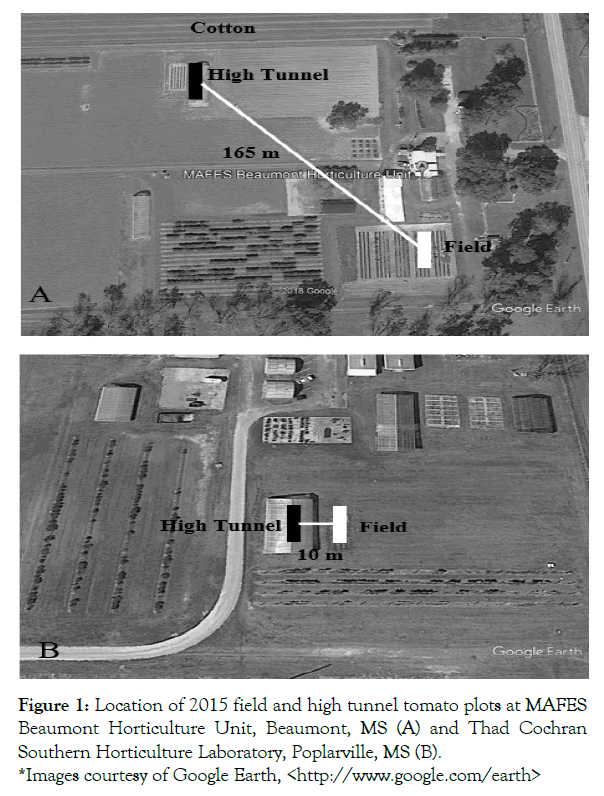
Figure 1: Location of 2015 field and high tunnel tomato plots at MAFES Beaumont Horticulture Unit, Beaumont, MS (A) and Thad Cochran Southern Horticulture Laboratory, Poplarville, MS (B). *Images courtesy of Google Earth, <http://www.google.com/earth>
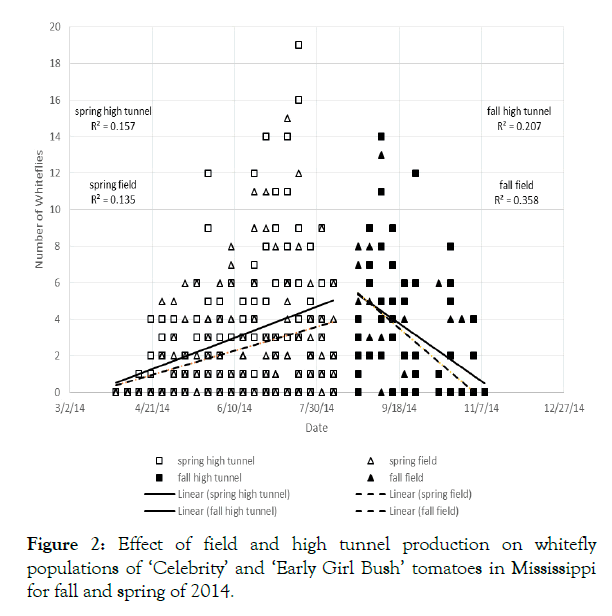
Figure 2: Effect of field and high tunnel production on whitefly populations of ‘Celebrity’ and ‘Early Girl Bush’ tomatoes in Mississippi for fall and spring of 2014.
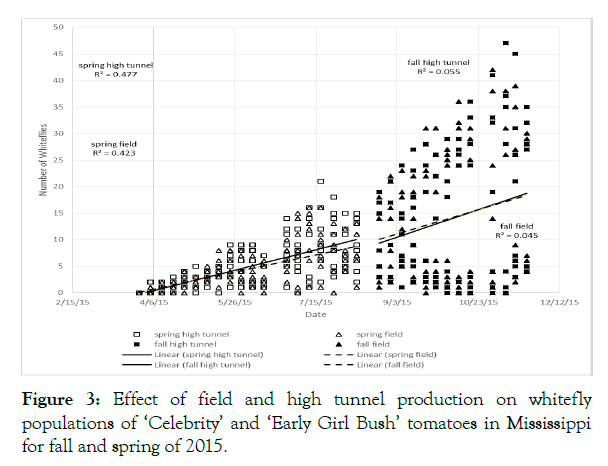
Figure 3: Effect of field and high tunnel production on whitefly populations of ‘Celebrity’ and ‘Early Girl Bush’ tomatoes in Mississippi for fall and spring of 2015.
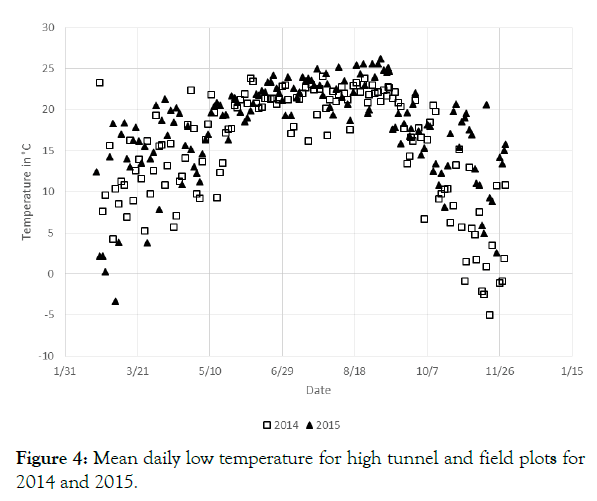
Figure 4: Mean daily low temperature for high tunnel and field plots for 2014 and 2015.
Aphid and thrips populations were low throughout this study. Fewer thrips were observed in 2015 than in 2014 (Table 2). Aphid populations were not affected by study year (Table 3). Location also affected aphid and thrips populations, with greater numbers observed at the Beaumont Horticultural Unit in comparison with the Poplarville and Wiggins, MS locations. Greater numbers of thrips were observed during the spring season than fall. Season did not affect aphid populations (Tables 2 and 3). No effect of variety or high tunnel production was observed for thrips or aphid populations.
| Independent Variables | Coefficient | Robust SE | |
|---|---|---|---|
| Weekz | -0.0187** | 0.0065 | |
| Yeary | -0.5228*** | 0.0961 | |
| Locationx | |||
| Poplarville, MS | -0.1921** | 0.0739 | |
| Biloxi, MS | -0.1485ns | 0.1508 | |
| Wiggins, MS | -0.5043*** | 0.1453 | |
| Seasonw | -0.3015*** | 0.0857 | |
| Varietyv | -0.0456ns | 0.0843 | |
| Methodu | -0.0826ns | 0.0807 | |
| Constant | 1.2518*** | 0.1502 | |
| No. of obervations | 964 | ||
| F-value | 8.23*** | ||
| R-squared | 0.0676 | ||
*Note: *, **, ***—Significant at 0.05, 0.01, and 0.001, respectively.
ns —Not significant at 0.05.
z – There were 20 weeks in spring 2014, 19 weeks in spring 2015, 11 weeks in fall 2014, and 13 weeks in fall 2015.
y – Benchmark year is 2014
x – Benchmark location is Beaumont, MS
w – Benchmark season is spring
v – Benchmark variety is ‘Celebrity’
u – Benchmark method is high tunnel
Table 2: Factors affecting populations of thrips on ‘Celebrity’ and ‘Early Girl Bush’ tomatoes under field and high tunnel conditions in Mississippi.
| Independent Variables | Coefficient | Robust SE | |
|---|---|---|---|
| Weekz | 0.0040ns | 0.0067 | |
| Yeary | -0.1648ns | 0.1108 | |
| Locationx | |||
| Poplarville, MS | -0.4342*** | 0.0933 | |
| Biloxi, MS | -0.4106* | 0.1674 | |
| Wiggins, MS | -0.7064*** | 0.1413 | |
| Seasonw | 0.1617ns | 0.0964 | |
| Varietyv | 0.0316ns | 0.0876 | |
| Methodu | -0.0001ns | 0.0872 | |
| Constant | 0.8986*** | 0.1448 | |
| No. of obervations | 964 | ||
| F-value | 5.48*** | ||
| R-squared | 0.0377 | ||
*Note: *, **, ***—Significant at 0.05, 0.01, and 0.001, respectively.
ns —Not significant at 0.05.
z – There were 20 weeks in spring 2014, 19 weeks in spring 2015, 11 weeks in fall 2014, and 13 weeks in fall 2015.
y – Benchmark year is 2014
x – Benchmark location is Beaumont, MS
w – Benchmark season is spring
v – Benchmark variety is ‘Celebrity’
u – Benchmark method is high tunnel
Table 3: Factors affecting populations of aphids on ‘Celebrity’ and ‘Early Girl Bush’ tomatoes under field and high tunnel conditions in Mississippi.
Whiteflies collected in this study included Bemisia tabaci and Trialeurodes vaporarium. All aphids identified were Myzus persicae. Thrips collected were identified as Frankliniella spp.
Effect of high tunnel on environmental factors
Air temperature in high tunnels and conventional plantings was measured and averaged between highest and lowest daily temperature (data not shown). Mean daily temperature measured in high tunnels was compared to that observed in conventional treatment plots. In 2014, mean air temperature difference across all treatment locations was 1.97°C with higher temperatures observed under high tunnels. The greatest mean air temperature difference (2.92°C) was observed at the Coastal Research and Extension Center site, and least difference (1.45°C) was observed at Beaumont Horticultural Unit. In 2015, average air temperature difference was 1.20°C (data not shown). Average air temperature difference over time for the two years of this study is shown in Figure 5.
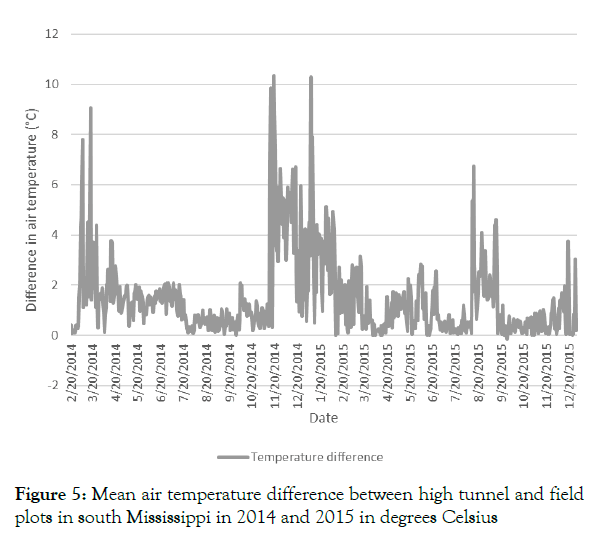
Figure 5: Mean air temperature difference between high tunnel and field plots in south Mississippi in 2014 and 2015 in degrees Celsius
Soil temperature differences were evaluated in the same way as air temperature. Mean soil temperature difference across all study locations was 2.67°C in 2014 and 1.63°C in 2015 (Figure 6). Highest soil temperature differences were obtained from the Beaumont Horticultural Unit in 2014 (3.70°C) and South Mississippi Branch Experiment Station in 2015 (1.71°C). Lowest mean soil temperature difference was obtained from Stone County USDA Research Station (1.35°C) in 2014 and from Beaumont Horticulture Unit in 2015 (1.56°C) (data not shown). Impact of high tunnel production on air and soil temperatures was greater during early spring, late fall, and winter. During these times, high tunnels were closed in response to low exterior temperatures.
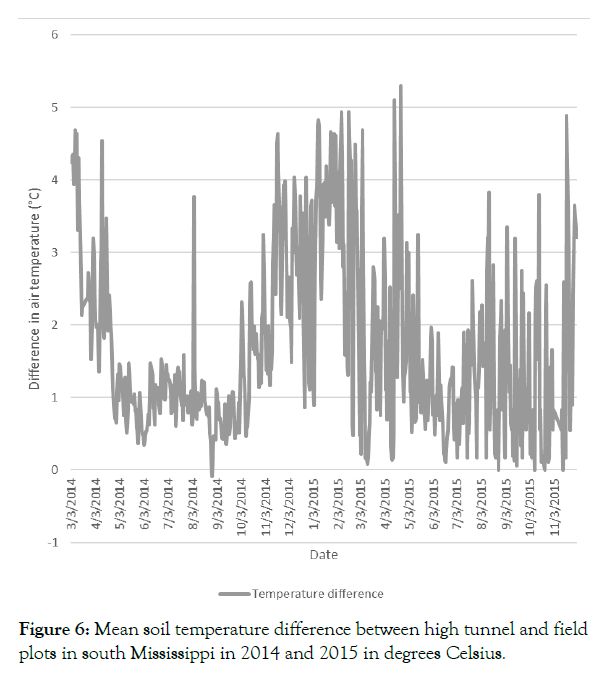
Figure 6: Mean soil temperature difference between high tunnel and field plots in south Mississippi in 2014 and 2015 in degrees Celsius.
Effect of high tunnel production on relative humidity was highly variable. In 2014, higher relative humidity was recorded at two of four study sites (Figure 7). Similarly, in 2015, higher relative humidity was observed at 1 of 2 study sites. In 2014, mean difference in relative humidity across study sites was 0.420 (data not shown). In 2015, mean difference in relative humidity was 0.584.
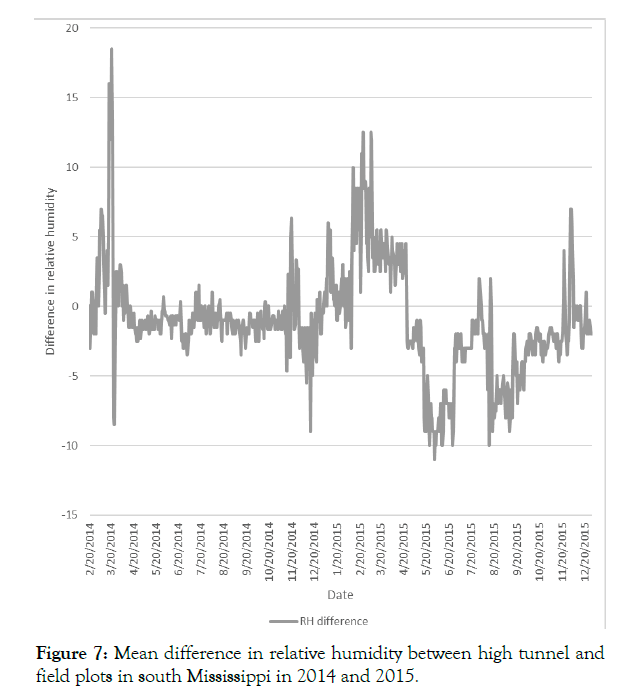
Figure 7: Mean difference in relative humidity between high tunnel and field plots in south Mississippi in 2014 and 2015.
Effect of high tunnel on plant growth
The empirical model defined in equation 4.1 explained 91.7% of the observed variation in plant height. The empirical model was significant as shown by the F-value (Table 4). Plant height was significantly affected by year of production, with greater plant height observed in 2014 in comparison with 2015. Season also played an important role in plant growth. Tomato plants grown during fall seasons did not reach greater maximum height, but grew more quickly during the fall season. Tomato plants at the Wiggins location were shorter than those at the benchmark location of the Beaumont Horticultural Unit. Differences were not observed between plant heights at other locations. As expected, tomato variety was a significant determinant of plant height, with the later maturing ‘Celebrity’ variety having greater plant height than the early maturing ‘Early Girl Bush’. Tomato plants grown in high tunnels were significantly greater in height than those grown under field conditions (Figure 8). According to the coefficient value, plants grown in the field were 14.5% shorter than those grown in high tunnels (Table 4).
| Independent Variables | Coefficient | Robust SE | |
|---|---|---|---|
| Weekz | 8.2858*** | 0.1175 | |
| Yeary | -6.5248*** | 1.4908 | |
| Locationx | |||
| Poplarville, MS | 0.6677ns | 1.2978 | |
| Biloxi, MS | -1.3663ns | 2.2511 | |
| Wiggins, MS | -4.2373* | 2.1421 | |
| Seasonw | 16.3067*** | 1.6058 | |
| Varietyv | -13.9425*** | 1.3455 | |
| Methodu | -14.4611*** | 1.2605 | |
| Constant | 8.0777*** | 1.9581 | |
| No. of obervations | 488 | ||
| F-value | 715.99*** | ||
| R-squared | 0.9169 | ||
*Note: *, **, ***—Significant at 0.05, 0.01, and 0.001, respectively.
ns —Not significant at 0.05.
z – There were 20 weeks in spring 2014, 19 weeks in spring 2015, 11 weeks in fall 2014, and 13 weeks in fall 2015.
y – Benchmark year is 2014
x – Benchmark location is Beaumont, MS
w – Benchmark season is spring
v – Benchmark variety is ‘Celebrity’
u – Benchmark method is high tunnel
Table 4: Factors affecting plant height of ‘Celebrity’ and ‘Early Girl Bush’ tomatoes under field and high tunnel conditions in Mississippi.
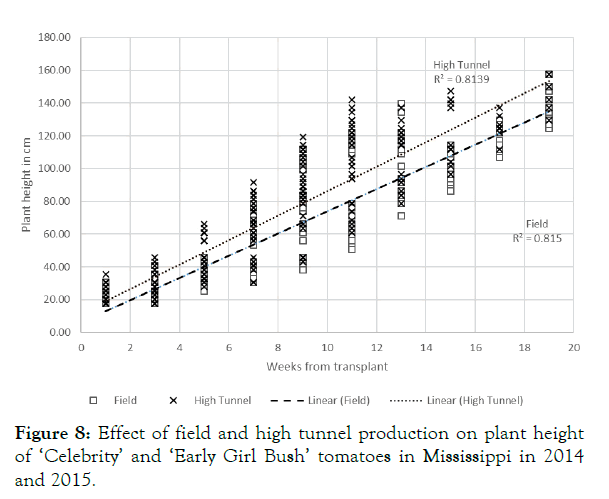
Figure 8: Effect of field and high tunnel production on plant height of ‘Celebrity’ and ‘Early Girl Bush’ tomatoes in Mississippi in 2014 and 2015.
Effect of high tunnel on insect populations
Populations of whiteflies were shown to be greater on high tunnel tomatoes than those grown under field conditions. Increased temperature in high tunnels presents a favorable environment for development of whiteflies. Temperature is an important factor affecting development, mortality, and fecundity rates for whitefly population [30]. Increased temperatures lead to faster developmental rates. Time from egg stage to adult in whiteflies was 38 days at 20°C and only 16 days at 30°C [30]. Longevity of adult whiteflies and oviposition rates are also affected by temperature with a similar relationship as for rate of development [31,32]. Increased temperatures observed in high tunnels in this study led to an increase in whitefly populations. Rainfall may lead to significant mortality in adult whiteflies [33]. Avoidance of mortality due to rain or other environmental factors may also lead to increased whitefly populations in high tunnels.
Greater numbers of whiteflies were observed in the longer season tomato variety ‘Celebrity’. ‘Celebrity’ tomatoes were greater in size and continued to produce new leaf tissue for longer than the earlier maturing ‘Early Girl Bush’ tomatoes. Whiteflies demonstrate a preference for feeding on newly emerged leaf tissue [32]. Preference for newly emerged leaf tissue may be based on physical factors such as the presence of trichomes or cuticle thickness. Additionally, chemical or nutritional factors may affect feeding preference. For tomatoes, young leaf tissue has a lower water content as well as increased sugar and nitrogen concentration. A positive relationship has been shown for leaf nitrogen and populations of Bemisia tabaci [31,34]. This, as well as the increased size of ‘Celebrity’ plants, accounts for the increase in whiteflies observed on the longer maturing variety.
Season played a significant role in the development of whitefly populations. Measurements of whitefly populations taken at the beginning of the fall season were similar to those taken at the end of the spring season, indicating that fall transplants were swiftly colonized after the removal of the spring planting. Due to this rapid colonization, whiteflies present a potentially serious issue for fall plantings of tomatoes. The small size of transplants leads to a dramatic increase in terms of whiteflies per total leaf area. Pest pressure during fall is increased due to two factors.
The first of these is an overall increase in pest insect populations for multivoltine species. With additional generations, number of offspring increases, leading to larger populations as the year progresses. The second factor affecting pest populations is the funnel effect. During fall season, fewer crop plants are present in the field, and there are less available food resources for pest insects. As a result, pest populations concentrate on the remaining plants.
In 2014, whitefly populations declined following relatively high populations at the start of the fall season. In 2015, whitefly populations continued to increase throughout the fall. This difference between study years is likely related to difference in temperatures. Typically high temperatures for Mississippi were recorded at the beginning of the fall season in both study years. In 2014, low temperatures were recorded earlier in the year than in 2015, leading to a decline in whitefly populations for all treatments in 2014 that was not observed in 2015 (Figure 4). Whiteflies have been shown to be killed or suffer cold injury at temperatures ranging from 0°C to 4°C with adults most susceptible to injury. Nymphs exposed to low temperatures may also take longer to mature even if subsequently exposed to increased temperatures [35,36]. Weather fluctuations between production years are difficult to predict, though producers should be aware of the potential for greater whitefly populations in years where low temperatures occur later in the fall.
Populations of whiteflies were much greater at the Beaumont Horticultural Unit due to cotton planted adjacent to the location in 2015. In the fall season, following harvest of cotton, whiteflies migrated to other available food sources including research plots for this study. High populations of whiteflies were observed on both field and high tunnel plots in the fall season. The location of high tunnel plots was closer to cotton plantings than the field plots. The difference in distance to cotton plantings did not lead to a difference in the date at which high populations were observed; however, it is possible that some preference may exist for dispersal to plants closer to the origin site. Whitefly dispersal has been extensively studied. Though whiteflies are frequently considered to be weak fliers, they are able to disperse easily and have been detected in traps away from areas of prevailing winds [31,37].
Populations of aphids and thrips were low throughout the four seasons included in this study. Due to these low populations it is difficult to draw conclusions regarding the effect of high tunnel production. Work conducted in protected raspberry production indicated that aphid populations were not increased by increased temperatures in high tunnels. The lack of ability of aphids to capitalize on increased temperature is accounted for by reduction in foliar amino acid composition [38]. Other studies have indicated that high tunnel production led to significant outbreaks of aphid populations [39]. High populations of aphids have been reported in screened high tunnels, with both temperature and exclusion of beneficial insects being proposed as the causative factor [21]. It is important to note that the importance of aphids and thrips, as well as whiteflies, is not entirely population dependent. Due to the ability of these insects to transmit viral pathogens, they may be damaging even at low populations [19].
Effect of high tunnel on environmental conditions
Effects of high tunnel production on environmental factors including soil temperature, air temperature, and humidity are similar to those reported in previous studies [8-10]. The effect of high tunnels on soil and air temperature allow for the earlier production of a variety of plants including tomato. Research conducted in Mississippi on high tunnel production of ‘Roma’ tomato indicated that early planting allowed for earlier harvest without any effect on yield [40]. The effect of high tunnels on humidity was varied, with both higher and lower measurements of relative humidity observed. In general, high tunnels protect plants from foliar fungal and bacterial pathogens due to the absence of free water necessary for disease development [41]. Humidity in high tunnels should be monitored as highly humid conditions are favorable for the development of fungal disease. High incidence of powdery mildew has been reported in high tunnels as a response to environmental conditions [19].
Effect of high tunnel on plant growth
High tunnels led to greater plant growth than observed for plants grown under field conditions. Effects of increased soil and air temperature on growth of tomatoes are well documented [42-45]. Optimum response to temperature increases is between 25°C and 30°C [46]. Plants grown under higher temperature conditions showed increased growth and were larger, having increased leaf area [46]. Effects of temperature on plant growth may be especially important for young plants. Young plants grown at lower than optimal temperature conditions develop thicker leaves, leading to decreased light interception and, in turn, decreased growth. High temperatures during early growth promoted expansion of leaves as well as early fruit production [47]. Promotion of early fruiting has been reported to occur at the expense of vegetative growth, which may lead to an overall decline in yield [48]. Yield data were not collected in this study due to the effect of sampling by removal of leaf and flower tissue for insect sampling. However, previous research conducted in Mississippi indicates that while plants may produce fruit earlier under high tunnel conditions, overall yields are not affected.
In this study, increased populations of whiteflies were observed on tomatoes grown under high tunnel conditions. Increased populations may be accounted for by increased temperatures as well as potential protection from rainfall. No effect was observed on aphid or thrips populations, though populations of these insects were low throughout the study period. Further evaluation of high tunnel production in regards to these insect pests is warranted. Increased populations of these insect pests would present a potential challenge to adoption of high tunnels for small-scale producers of tomatoes and other horticulture crops in Mississippi. Effects of high tunnel production on environmental factors and growth of tomato plants observed in this study are similar to those previously reported. Given much of high tunnel production is dedicated to minor or specialty crops, as well as increasing interest in organic production, impacts of production practices on insect populations can be important for management strategies. Additional practices associated with high tunnel production, such as the use of low covers and exclusion netting may provide for positive effects in reducing crop damage from pests.
Citation: Stephenson RC, Coker CEH, Posadas BC, Bachman GR, Harkess RL, Adamczyk JJ (2019) Effect of High Tunnels on Populations of Whiteflies, Aphids and Thrips on Tomatoes in Mississippi. J Hortic 6:259. Doi: 10.35248/2376-0354.19.06.259
Received: 06-Jul-2019 Accepted: 26-Jul-2019 Published: 02-Aug-2019
Copyright: © 2019 Stephenson RC, et al. This is an open-access article distributed under the terms of the Creative Commons Attribution License, which permits unrestricted use, distribution, and reproduction in any medium, provided the original author and source are credited.